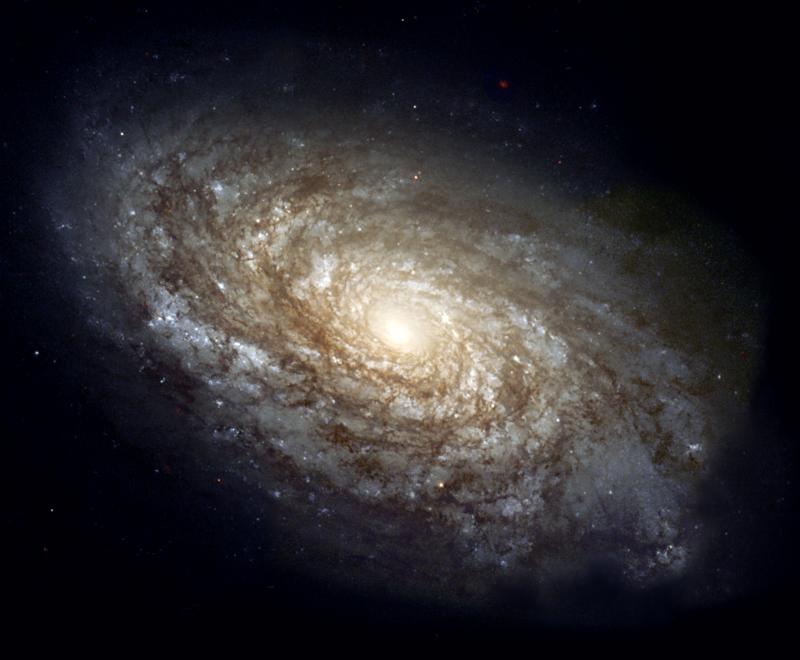The whole point of putting telescopes in orbit is to avoid distortions caused by our murky atmosphere. But now astronomers say they have calculated only half the light of our universe reaches telescopes, even those in orbit, because of the amount of dust that permeates the universe. In essence, they say, the universe is twice as bright as previously thought. The lead author of a new paper detailing this discovery, Dr. Simon Driver from the University of St Andrews said, “For nearly two decades we’ve argued about whether the light that we see from distant galaxies tells the whole story or not. It doesn’t; in fact only half the energy produced by stars actually reaches our telescopes directly, the rest is blocked by dust grains.”
While astronomers knew the universe contains small grains of dust, they hadn’t realized the extent to which this is restricting the amount of light that we can see. The dust absorbs starlight and re-emits it, making it glow. They knew that existing models were flawed, because the energy output from glowing dust appeared to be greater than the total energy produced by the stars.
Dr. Driver said, “You can’t get more energy out than you put in so we knew something was very wrong. Even so, the scale of the dust problem has come as a shock – it appears that galaxies generate twice as much starlight as previously thought.”
The team used a new model of the dust distribution in galaxies from a catalogue of 10,000 galaxies to precisely calculate the fraction of starlight blocked by the dust. The team says dust blocks approximately half of the light that the Universe generates.
The Universe is currently generating energy, via nuclear fusion in the cores of stars, at a whopping rate of 5 quadrillion Watts per cubic light year, about 300 times the average energy consumption of the Earth’ population.
After measuring the brightness of thousands of disc-shaped galaxies with different orientations, the astronomers matched their observations to computer models of dusty galaxies. From this they were able to calibrate the models and, for the first time, determine how much light is obscured when a galaxy has a face-on orientation. This then allowed them to determine the absolute fraction of light that escapes in each direction from a galaxy.
While modern instruments allow astronomers to see further into space, they can’t eliminate the obscuring effect from these tiny dust grains. “It is somewhat poetic that in order to discover the full glory of our Universe we first had to appreciate the very small” said Dr. Alister Graham from the Swinburne University of Technology.
The team consists of astronomers from the United Kingdom, Germany and Austrailia. Their research was published in the May 10 issue of Astrophysical Journal Letters.
Original News Source: Science and Technology Facilities Council


With so much dust out there, could there be any implications on dark matte theories?
That’s what happens when you build something without providing in advance for its future lifelong maintenance. There are many public projects with the same problem.
It must be Billions of years since anyone dusted this universe, small wonder it’s full of dirt!
so, since we use light for almost all of the measurements of the universe, could the knowledge we have hypothesized and “proven” by studying light be entirely incorrect?
300!!! as in “about 300 times the average energy consumption of the Earth’s population.” How may zeros are missing?
RE: 300!!!
That was my first reaction too, then I realized that they’re talking about energy per cubic light year. And, since stars are few and far between — MOST cubic lights are empty! This brings the average WAY, WAY,
down.
Re: 300
Chuck makes a good point. I withdraw several of the exclamation points. Someone called it the Big Empty
Are there any implications about distance measurements and so-called “dark energy”? Could it be that distant type 1a supernovae are dimmed by dust, rather than by expansion of the universe, so expansion is not really accelerating, and “dark energy” really doesn’t exist?
Whoops! Looks like this little mistake may have other ramifications. Time to crunch those numbers again.
I too am wondering about the implications for dark matter/energy theories. This is a fairly huge discovery, yes?
Major, major implications for supernova research: Are the distant standard candles twice as bright as most researchers thought they are? Or has the supposed acceleration of the universe accelerated even more than anticipated? Either answer has profound implications for Einstein’s universe…and WMAP interpretations.
I don’t see how this would have implications for dark matter hypotheses (note my choice of words), I *do* see a major implication of damnation on what we regard as dark energy. The whole of the dark energy hypothesis is based on the brightness of distant supernovae that was observed by the Hubble Telescope, and this revelation could have serious consequences on the idea that the acceleration of our Universe is increasing.
I may be an amateur at astronomy, but I have a sneaking suspicion this could one of those “Eureka!” moments here.
Hmm . . . maybe only half the light reaching our telescopes because of cosmic dust! Interesting. If so, this doesn’t bode well for the SETI efforts to detect modulated femto-watt radio signals.
Someone break out the Dyson!!
Regarding Dark Matter (or should it be re-named ‘Dust’), if Scientists have worked out the average mass distribution of dust in the Universe, couldn’t that help solve the problem or at least provide a starting point?
I could also be completely off-target, in which case I aplogise in advance.